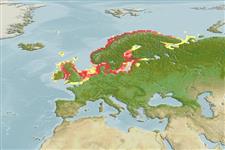Common names from other countries
Environment: milieu / climate zone / depth range / distribution range
Ekologi
laut; payau dasar (demersal); kisaran kedalaman 0 - 40 m (Ref. 31184), usually 2 - 20 m (Ref. 35388). Temperate; 72°N - 49°N, 11°W - 52°E
Northeast Atlantic: White Sea, Cheshskaya Guba and Murmansk coast (Barents Sea) southward to English Channel (River Somme); eastern coasts of Scotland, England, also Irish Sea; the Orkneys, Shetlands and in shallow waters of North Sea and Baltic.
Length at first maturity / Size / Weight / umur
Maturity: Lm 17.0, range 16 - 18 cm
Max length : 52.0 cm TL jantan/; (Ref. 4695); common length : 30.0 cm TL jantan/; (Ref. 4695); Berat maksimum terpublikasi: 510.00 g (Ref. 6397); Umur maksimum dilaporkan: 10 Tahun (Ref. 35388)
Bones are green due to harmless pigment. Skin slimy and variable color (Ref. 35388).
Inhabits rocky shores under stones, among algae and in tide pools, between tide marks down to 40 m. May remain out of water under rocks or seaweeds (Ref. 31184). Feeds on gastropods, chironomids, crustaceans, eggs and fry of fishes. Gives birth to live young (Ref. 9900). Bones colored green by the harmless pigment Vivianit (Ref. 4645). Breathes air when out of water (Ref. 31184). Mating takes place in August - September with internal fertilization of the eggs. Female give birth to 30-400 developed young (35-55mm) (Ref. 35388).
Fertilization occurs in August-September. Egg development lasts for one month. Total bearing time is five months (Ref. 6397).
Andriashev, A.P., 1986. Zoarcidae. p. 1130-1150. In P.J.P. Whitehead, M.-L. Bauchot, J.-C. Hureau, J. Nielsen and E. Tortonese (eds.) Fishes of the North-eastern Atlantic and the Mediterranean. volume 3. UNESCO, Paris. (Ref. 4695)
Status IUCN Red List (Ref. 130435)
CITES (Ref. 128078)
Not Evaluated
ancaman kepada manusia
Harmless
penggunaan manusia
Perikanan: nilai komersial kecil; Akuarium: Akuarium publik
Alat, peralatan
laporan khas
muat turun XML
Sumber internet
Estimates based on models
Preferred temperature (Ref.
115969): 7.3 - 11.3, mean 9.4 (based on 310 cells).
Phylogenetic diversity index (Ref.
82804): PD
50 = 0.5156 [Uniqueness, from 0.5 = low to 2.0 = high].
Bayesian length-weight: a=0.00316 (0.00188 - 0.00531), b=3.13 (2.97 - 3.29), in cm Total Length, based on LWR estimates for this species & (Sub)family-body (Ref.
93245).
Trophic level (Ref.
69278): 3.5 ±0.49 se; based on food items.
Daya lenting (Ref.
120179): Rendah, Waktu penggandaan populasi minimum 4.5 - 14 tahun (tm=2; tmax=10; Fec=30; K=0.19-0.4).
Fishing Vulnerability (Ref.
59153): High vulnerability (60 of 100).
Climate Vulnerability (Ref.
125649): Very high vulnerability (84 of 100).
